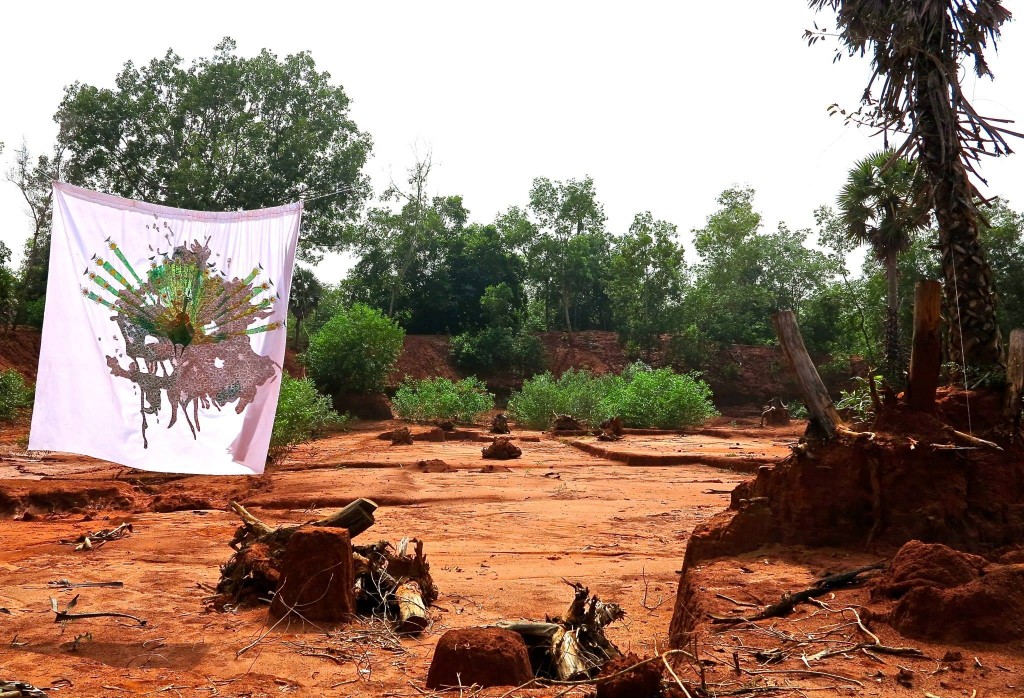Yassine “Yaze” Mekhnache will present a large body of work embodying the artists journey over the past 7 years through a collaborative project of embroidery and painting. ‘The Conference of the Birds” will encompass 30 paintings illustrating and delving into a mystical journey loosely based on the 30 birds of attar. A monumental exhibition for the artist and David Bloch Gallery will open Feb 27th in Morocco. You can read more below about Yaze and “The conference of the Birds”.
GF
Yaze – THE CONFERENCE OF THE BIRDS – February 27 > March 24, 2015
Yassine Yaze Mekhnache will present his first solo exhibition THE CONFERENCE OF THE BIRDS [منطق الطير] at the David Bloch Gallery in Marrakech from February 27 to March 24, 2015.
The opening will take place in the presence of the artist on February 27 at 7:00 pm.
This first solo exhibition in Morocco promises to be a blast of his work – he has been sharing since nearly 10 years close ties with Morocco, especially through his collaboration with Moroccan embroiderers.
Indeed since 2007, Yaze expresses the link between tradition and modernity through his work on the cotton’s fabrics weaved traditionally by the embroiderers of Tamesloht. By this mixed marriage of the fineness of the embroideries and the energy of his work, Yaze takes us into a vibrant pictorial world.
This exhibition is also another step in the journey and the search of the artist – the horizon stretches to the East and especially to Pondicherry in India.
Graphical impacts and figurative drawings merge together, the traditional Moroccan embroideries blend into the delicate Indian silks and beads giving birth to the birds of Attar, inviting us to a mystical journey into the imagination of the artist.
2015 also promises to be an exceptional year for Yassine Mekhnache with the release next March of the documentary entirely devoted to him by Rachid Djaïdani.
———-
« The embroidery is the result of a co-operation with the women of the small Village of Tameslohte.
They have strong ties with him, the palms of their hands wear Henna tattoos running along the heart lines, they find great pride in getting the opportunity to unveil their creativeness and reach some kind of immortality without blasphemy.
Yaze tells me that the women of Tameslohte, long before the Thousand and One Nights, were sharing encoded information through the silent language of their embroidery.
There is a kind of secret, a pin code that he will never decipher, and this creates a bewitching effect when the iris hits the painting. »
Rachid Djaïdani
———-
« Seven years ago, Yassine Mekhnache came across the path opened in the twelfth century by the poet Farid Attar, which generations of men concerned with self-fulfillment have traveled; a path to the inner divine, caught in the eye of others; a path of selflessness and love whose infinite awareness escapes the filter of pure reason; a path of rejection of earthly vanities which the thirty birds of Attar perilously traveled to join their king Simorgh.
A real fresco in the making, Yassine Mekhnache’s pictorial research around Farid ud-Din Attar’s ‘Conference of the Birds’, an emblematic story of the Sufi wisdom, is a variation on the theme but in no way replaces it or is constrained by it, on the contrary.
The painter’s gesture, fueled by its own means, extends the writing of the poet through the experience of the universal language introduced by Attar; because The Conference of the Birds is the journey of the soul, both braced against and embracing the other’s self to form the divine sum.
This bond of love between men as a recurrent thread leading to divine unity, between the One and the Many, is summarized in two syllables, Si and Morgh: taken literally, Si-Morgh means, in Persian, thirty birds, whereas a linguistic subtlety, removing the hyphen, turns thirty birds into a fabulous creature, Simorgh, king of the birds and allegory of divine abstraction.
The vision of the ongoing project builds on this intuition of matrix unity woven from a multiple humanity: a composition of thirty monumental canvases, each a powerful expression of the discourse of the whole of which they are part, materializing in pictorial terms the metaphor of human communion.
Over thirty years of unbridled pursuit to a ghostly and multifaceted face, around which the artist’s approach is built, the last seven were closely accompanied by Attar’s story, so closely that the ascendance of the poet on the painter gave the measure of time, space and the means of expression required to redefine its scope; the final imprint of trips to the Orient, performed so often that voyages there and back have interfered with each other to the point where they blend into one; brushes were dropped in favor of inks, to open then close interpretations of his own matrices embroidered by others, whose needle and thread pierce then heal veins and shadows, on the other side of the world.
The continuum between the primitive impact, which the artist projects onto each canvas as if a spell were cast, and the minutia of the ligatures that embroiderers entwine on each canvas as if they were gazing on onto the Unknown contained in the self, polarized and therefore reverses the incessant shuttling of scale between Chaos and Cosmos, Speed and Slow Motion, Abstraction and Figuration, Near and Far, Self and Other. These degrees of time, space and cultures, accrued on each canvas of the sum, serve to measure their common spectrum, that face, the impending absence of which is now composed of the anonymous and multiple power of a human chain that each observation of the canvas transcends. »
Celia DECALONNE











